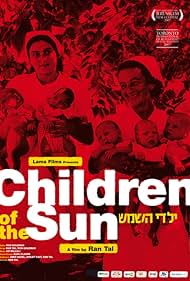An intimate portrait of the children who were part of Israel's first kibbutzim.An intimate portrait of the children who were part of Israel's first kibbutzim.An intimate portrait of the children who were part of Israel's first kibbutzim.
- Director
- Writers
- Awards
- 3 wins
Photos
Storyline
Featured review
The big question in Children of the Sun involves the radical departure from traditional child rearing practices taken, beginning in the 1930s, by socialist kibbutzim in the area of the Middle East that became Israel: Is it better for children to be raised communally rather than in nuclear families? The film combines home movie footage from kibbutzim with comments about it by elderly participants, some of them pictured as children in the films.
Director Ran Tal's approach is quite different from that of talking-head documentaries. In this context, it is brilliantly insightful. Rather than hearing a voice-over narrative explain socialist principles and the perceived need to create a new, socialist man, we see children playing in nurseries and, at an early age, working in orchards and fields. All activities, including showering and going to the bathroom, are performed collectively. Contact with parents, who live in small rooms apart from their children, is minimal. In the daytime, the children look vigorous and happy. At night, in their separate quarters, they cry frequently.
Comments by the former kibbutzniks, now in their sixties, seventies, and eighties, contain both nostalgia and bitterness. They look back to a more idealistic time, when they saw themselves as creators of a new society, for Jews and, ultimately, for all humanity. At the same time, there are many resentful personal memories, of demands for social conformity, loneliness, and an inability to develop close emotional relationships. Seeing the old movies brings back memories and the people being interviewed have a lot to say.
Kibbutzes are not the only institutions that have tried to implement collective child rearing practices. In the early Soviet Union, in China after the 1948 revolution, and, in its most extreme form, in Cambodia under the Khmer Rouge, there were massive efforts to collectivize child rearing, along with other social activities. A major difference, however, is that adult kibbutzniks were there because they wanted to be, not because they were forced into collective arrangements by a totalitarian state. Due to this factor, the kibbutz experience can reveal, in a pure and non-poisoned way, what happens when children are raised in groups of other children of the same age rather than with parents.
At least one of the kibbutzim in the movie rejected collective child rearing and had children live with their parents. Several of the people interviewed in the film see the kibbutz movement as a failure, a view shared today by many Israelis, though some kibbutzim continue to exist. Whatever its failures and successes, the kibbutz experience addresses fundamental social issues and deserves continuing examination and analysis. Ran Tal and his associates have made an important contribution.
Director Ran Tal's approach is quite different from that of talking-head documentaries. In this context, it is brilliantly insightful. Rather than hearing a voice-over narrative explain socialist principles and the perceived need to create a new, socialist man, we see children playing in nurseries and, at an early age, working in orchards and fields. All activities, including showering and going to the bathroom, are performed collectively. Contact with parents, who live in small rooms apart from their children, is minimal. In the daytime, the children look vigorous and happy. At night, in their separate quarters, they cry frequently.
Comments by the former kibbutzniks, now in their sixties, seventies, and eighties, contain both nostalgia and bitterness. They look back to a more idealistic time, when they saw themselves as creators of a new society, for Jews and, ultimately, for all humanity. At the same time, there are many resentful personal memories, of demands for social conformity, loneliness, and an inability to develop close emotional relationships. Seeing the old movies brings back memories and the people being interviewed have a lot to say.
Kibbutzes are not the only institutions that have tried to implement collective child rearing practices. In the early Soviet Union, in China after the 1948 revolution, and, in its most extreme form, in Cambodia under the Khmer Rouge, there were massive efforts to collectivize child rearing, along with other social activities. A major difference, however, is that adult kibbutzniks were there because they wanted to be, not because they were forced into collective arrangements by a totalitarian state. Due to this factor, the kibbutz experience can reveal, in a pure and non-poisoned way, what happens when children are raised in groups of other children of the same age rather than with parents.
At least one of the kibbutzim in the movie rejected collective child rearing and had children live with their parents. Several of the people interviewed in the film see the kibbutz movement as a failure, a view shared today by many Israelis, though some kibbutzim continue to exist. Whatever its failures and successes, the kibbutz experience addresses fundamental social issues and deserves continuing examination and analysis. Ran Tal and his associates have made an important contribution.
- johnpetersca
- May 10, 2008
- Permalink
Details
- Release date
- Countries of origin
- Language
- Also known as
- Children of the Sun
- Filming locations
- Production companies
- See more company credits at IMDbPro
- Runtime1 hour 10 minutes
- Color
Contribute to this page
Suggest an edit or add missing content





